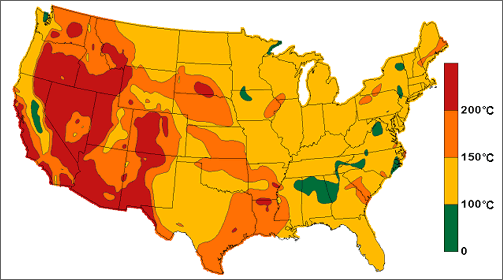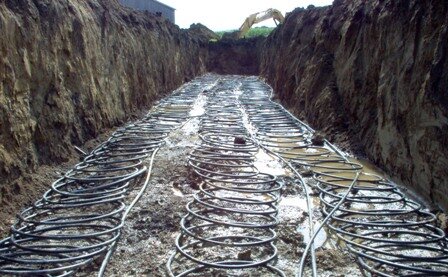Setting up a Geothermal system is one way you can harness clean energy directly under your feet. If you are thinking about heating, ventilation, and air conditioning while off-grid, then you are thinking of Geothermal energy.
Geothermal energy uses the constant temperatures from underneath the ground to provide cooling and heating to your home. Have you been in a cave where the temperature is warmer than the air above it during the winter and cooler than the air in the summer? That’s how geothermal systems work.
Yes, I know, the most challenging con for a Geothermal air conditioning and heating system would be its upfront setup cost. But that's if you're getting an excavator and a whole service company to get it up and running.
Shutting the windows during the day and opening them at night, planting trees and shrubs at the east and west side of the home for shade, taking a dip in a creek, or probably using hand fans has been the common way to stay cool off grid.
But all thanks to mother Earth, we can enjoy benevolent clean off-the-grid air conditioning - Geothermal air conditioning.
The good thing is, in this article, you will find a simple DIY Geothermal system to set up all by yourself, or you can use a little help.
Are you ready?
Types of Geothermal Systems
Geothermal systems are categorized into two categories - closed-loop system and open-loop system.
The closed-loop system has been the dominating choice. In a closed-loop system, there are three types of configuration.
Horizontal - Requires trenches to be deepest, 6 feet with enough land to stretch out the looping pipes. The horizontal system is pretty easy and does well for a DIY project - that's why we are going with the horizontal.
Vertical - Requires drilled holes up to 300 feet into the earth like a well and are often used in urban areas with little land space. This is definitely not the kind of system you should map out yourself. When it comes to verticals, we leave it to the professionals.
Pond/Lake - Looping pipes are placed at least 8 feet deep under the surface of a water body. Of course, you can only try this if you have a nearby water body. Still, you need a professional to help you out.
The open-loop system does not need pipes to be looped. This system uses a well or a surface water body as its heat exchanger. Once the water drawn from the well or water body surface has circulated the system, it is then released back into the ground or the water surface body.
Open-loop systems are regulated by the EPA since water is put back into the environment.
What to Consider Before Setting up a Geothermal System
Before you start digging holes or lining up trenches into the earth, there are things you have to put into consideration. These things include:
The size of your land space - The available land space is what tells you you have to dig out a vertical or horizontal trench and how far they extend to accommodate looping pipes.
Climate of your state or country - As the above map shows different parts of the country have varying temperatures six feet below the surface. Depending on where you live, ground temperatures six feet below the surface average from 45°F (7°C) to 75°F (21°C).
Soil type - Another variable that could make you dig in further is soil type. Dry soil doesn't do good in transferring heat. Moist soil does better. So if you have dry or sandy soil on the level where you've dug, it still means you will have to dig further until you find a moist or dense clay. Your local USDA office can help you with soil maps for your area.
Other things that can also be taken into account are the house heating and cooling load, underground utilities and sprinkler system (if you don't mind the cost), and local building regulations. You will need to know where any electrical, water, or leach lines run from the home.
A three-ton slinky loop prior to being covered with soil. The three slinky loops are running out horizontally with three straight lines returning the end of the slinky coil to the heat pump. Photo by Mark Johnson
Components for the Geothermal System
Just to make the whole process easy and less costly, it's better off sourcing for simple affordable equipment that could be laying around us.
For digging up the trench, a spade or shovel might just get the work done. But if you are looking forward to saving yourself time and energy, using a backhoe is a great idea. Many rental equipment companies have excavators.
For the looping pipes, a simple plastic pipe would be okay, but since we are more interested in the pipe's efficiency to transfer heat, looking into a High-Density Polyethylene (HDPE) Pipe is not a bad idea.
A 12V brushless water pump is used to power the water circulation through the [closed] looping system. And a car radiator is used as the heat exchanger.
But again, geothermal air conditioning systems still need a power source to power the whole system. Usually, a battery is used to power the car's radiator fan and the water pump, but it wouldn't serve efficiently or for a long period of time without you having to recharge.
So I suggest having the system powered by the sun and at the same time, having the battery recharged for the night.
Cost of Setting up a Geothermal Air Conditioning System
Still holding up the banner for a cheap geothermal air conditioning system, we will be looking into sourcing parts as cheaply as possible.
Almost every home has a spade or shovel. I think they are one of the most common working tools that can be laying around. This makes it easy for you to borrow from a next-door neighbor if you don't have one.
A 500 feet geothermal PE looping pipe with 20mm thickness would cost about $100 or a little more.
If you have an old car you don't drive anymore, you can take out its radiator. But if not, you can stop by an auto parts store to buy an aftermarket radiator of $35 and a 12V brushless water pump for about $18.
We talked about a power source for the radiator and the water pump too. You can get a 30W portable foldable solar panel battery charger kit for about $58. It is enough to power the system and charge an extra battery you could use when the sun is down.
The prices are bound to vary since we have tons of models and brand makers in the market.
The Setup Process
So before we go on to dig, be sure to have a building permit from your local jurisdiction first (in regions that require you to have one).
Use your spade or hand digger to dig, dig, dig. The ideal trench depth for a horizontal system is usually 4 - 6 feet and spanning up to 400 feet in length for a horizontal looping system
After the trench is completely dug, layout your looping pipes on the ground through to the end of the trench. Note that we are following a closed looping system here. So you have to lay out your pipes in a way to make both the inflow/outflow pipe holes face your home.
Connect the side of the water pump that takes in water to one end of the looping pipe and connect the other side that pumps out water to the top hose of the radiator. The aim is to get water that has gone through the looping pipe to run into the radiator. Connect the lower hose of the radiator which should allow for outflow back into the looping pipe that has been buried underground.
Some would prefer using thermal pipes to make connections between the water pump, the radiator, and back to the looping pipes. But if you don't have any and can afford to make a clean connection, it's absolutely fine. After the connection is done and both the radiator and water pump have been plugged into your solar power source, place the radiator at a height high enough to circulate air in the room.
Advantages of a Geothermal Air Conditioning System
It is renewable energy, energy is totally free.
Great way to reduce your carbon footprint.
Almost no maintenance cost.
It is effective in all regions and climates.
Suitable for most homes and businesses.
It is totally safe and environmentally friendly.
Disadvantages of a Geothermal Air Conditioning System
Lack of land availability can be a drawback.
Important underground work can be destroyed during the digging process.
High upfront setup cost.
The system still has to be powered by an external source.
Guest Author, Ben Danor, is a Cross Riverian who cares for his environment. He writes on a wide range of genres. In his spare time, he writes lyrics and compose songs. He is also a lover of animals.
You can also Write For Us




